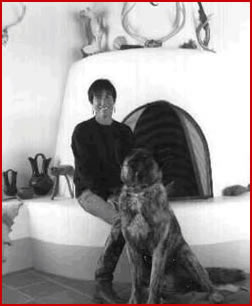
| Art Gallery |
| About the artist |
| Bibliography |
| ... Exhibitions and Awards |
| ... Selected Bibliography |
| ... Tributes |
| Contact |
| Tributes | |
Sadness trembled in the Earth and its animals, not in people alone, when Susan Hertel crossed over the river. Back and forth she went in life - the hillside, a horse, a dog in a sunlit room - saying in conversation, in paintings, in letters, and poems, Here this line, this hue, this moment, it's all the sign one needs against the dark. She saw, and she handed on lovingly the seeds she found. - Barry Lopez |
|
| For Sue Hertel
When I was a little girl Years passed and I met another No explanations...but... It is there in the smile -Rina Swentzell |
 |
| Remembering Sue Hertel March 24, 1993 Sue Hertel is dead at age 63. I first met Sue 40 years ago. I was a sophomore at Pomona College, doing my art classes at Scripps College. I never met her formally. No one ever introduced us. She was already established on the premises. I was an invisible undergrad, just another art student. Only as I began to assert myself as a “serious” art student did Sue begin to recognize me as a person. That doesn’t mean that she ever acknowledged my presence or that we became friends. She was 4 years older and light-years wiser. In those days, Sue was a rather formidable young woman. She was a no-nonsense, serious artist. This was 1953, years before Women’s Lib or the Feminist movement. Sue was way ahead of her time. She was special. She was more than willing to compete against the boys. Because of her talent and commitment, her passionate commitment to art, she established herself as an artist. She could draw and she could paint and she never wavered. In the 40 years I knew her she never wavered. Sue never cared that art was male-dominated. She saw that there was room for exceptional talents like Mary Cassatt and Suzanne Veladon. And over the years as she matured as an artist, she became one of the very best of her generation. She was a class act. There was something patrician about her, innately aristocratic. She held her head high. I think that she was truly proud of herself, of what she had accomplished. Most of all, most important of all for the artist, she knew her work was special. As a young artist, I had two role models there at Scripps. One was Jack Zajac and the other was Sue. From them I learned that to be a real artist meant to do real work, to be totally committed, to never look back. That’s the way we were then. That’s the way we kept on being. The young Sue was striking in appearance with fine features and raven black hair. She was beautiful because of an inner radiance. She radiated conviction and integrity. Her work was inviolate. Throughout the 4 decades that I knew her and saw her as an assistant to Millard Sheets, as a wife and mother, as an exhibiting artist, as a resident of Claremont, Glendora, and New Mexico, her artwork was a constant. It will remain as an enduring monument to her unwavering vision. She painted all the things she loved and cared about. She lived a full life, a rich and rewarding life. I will miss her and I will always respect her for who she was and for what she was: a very fine person and a very fine artist. - James Strombotne
|
|
| A CASUALTY
“Yes,” she said, “when the Gulf war started, Then the same old long-defeated It was time then She loved them all, that breathes her still. - Kate Barnes |
|
 Susan Hertel 2015 © All Rights Reserved.
Susan Hertel 2015 © All Rights Reserved.